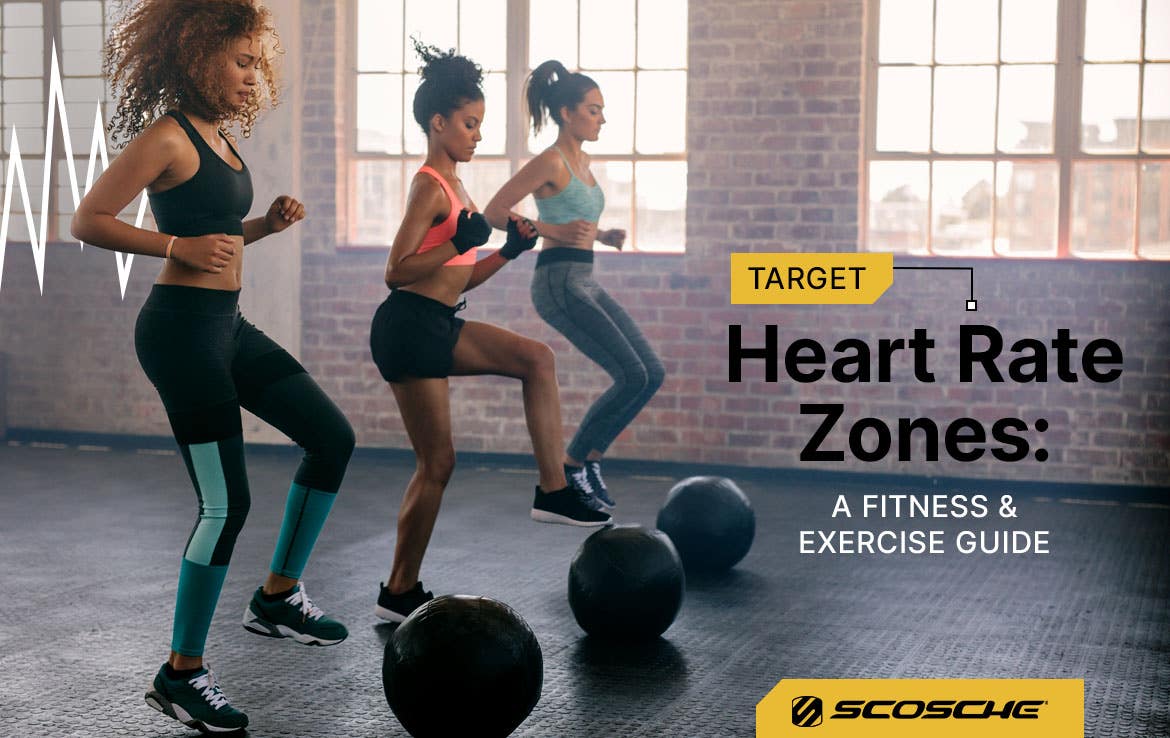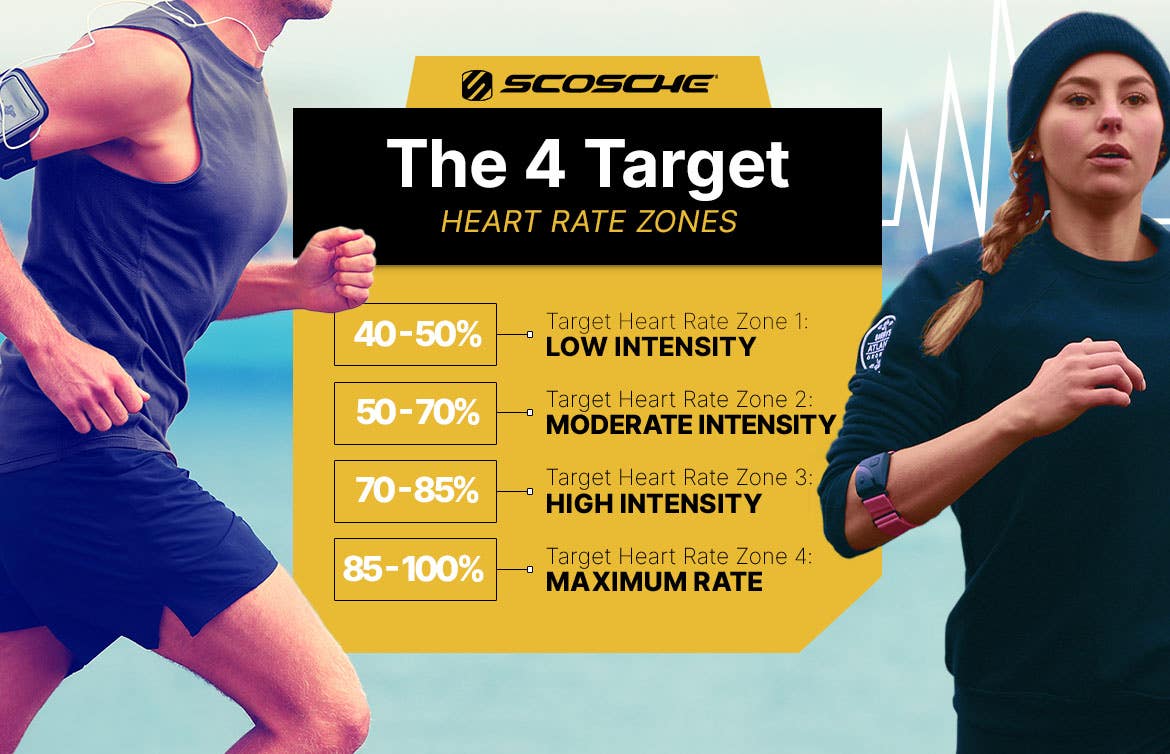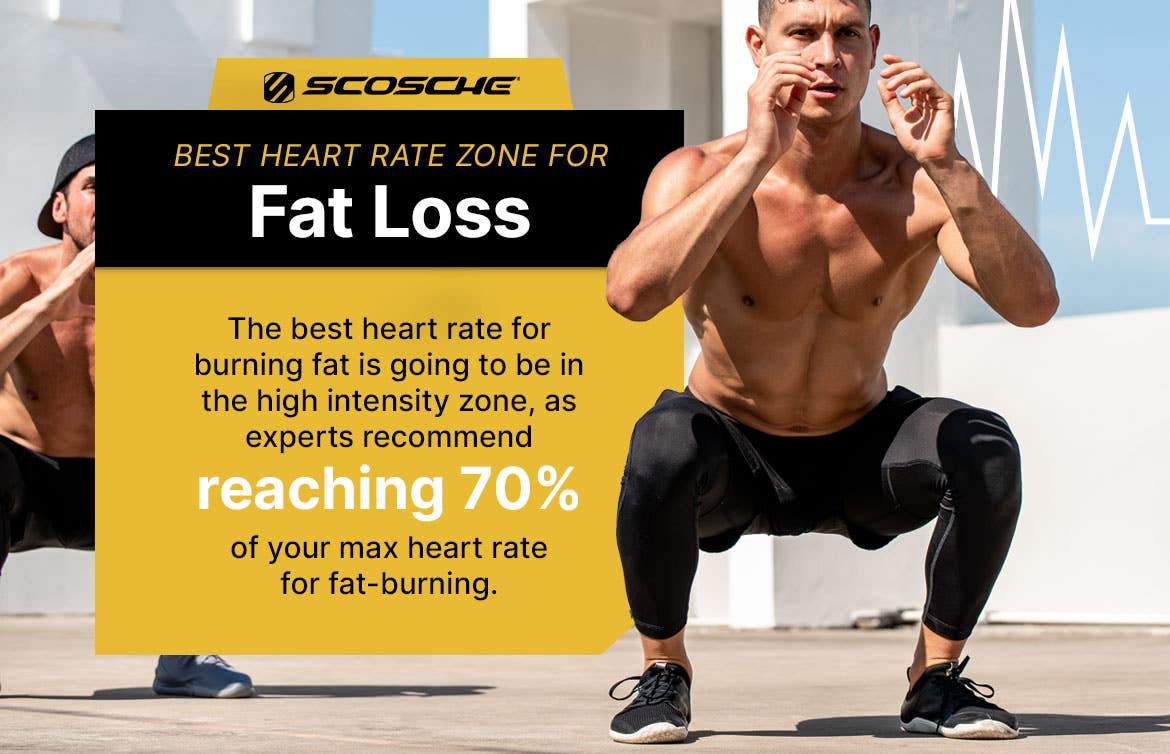Target Heart Rate Zones: A Fitness and Exercise Guide

A person’s heart rate is determined by measuring the number of times their heart beats in a single minute. This number can provide someone with a significant amount of information about how well and how hard their heart is working while exercising or at rest.
Additionally, a person’s heart rate can be measured manually or by using a precision heart rate monitor.
On the other hand, finding your target heart rate (which is how fast your heart should be beating during exercise) requires that you first find your maximum heart rate, as your target will be a percentage of this figure.
However, target heart rate can be a bit more complex than a single number, as it is also divided up into target heart rate zones.
Shop Premium Wearable Heart Rate Monitors from Scosche
If you are ready to take your knowledge and understanding of target heart rates a bit deeper, then read on about what target heart rate zones are, how they are categorized and other useful information.
Let’s get started.
What Are Target Heart Rate Zones?
Target heart rate zones utilize your maximum heart rate as a guide and chop this figure up into various intensity zones to measure how vigorously you are exercising.
Different target heart rate zones can be utilized based on a person’s level of athleticism, the type of exercise being performed and other factors which could modulate the desired zone.
That said, in order to figure out which target heart rate zone you should be inhabiting at any given time, it is first necessary to establish your target heart rate.


Finding Your Target Heart Rate
When aiming to find your target heart rate, it is important to understand that there are a number of variables that will impact the final number, including:
- Age
- Gender
- Level of fitness
- Potential medical conditions
This is because, as mentioned a moment ago, your target heart rate will be based on your maximum heart rate. Therefore, understanding how to determine your maximum heart rate is an essential first step.
Since numerous factors impact this number and various calculations can be used, here, we will employ the most basic method, which is to simply subtract your age from 220. However, it is recommended that you use a more sophisticated formula and factor in your personal specifics.
Alternatively, you can also potentially use a precision wearable heart rate monitor to find the correct figure for you as many of these devices will now ask users for information pertaining to their gender, age and other particulars to determine maximum heart rate, target heart rate and target heart rate zones.
While exercising, these kinds of devices can inform users on their target heart rate, as well as which target heart rate zone they are currently inhabiting, based on their level of exertion.
That aside, with your target heart rate established, you can then begin dividing that figure up into different zones, based on intensity.
On that note, let’s dive into the different heart rate zones you might aim to reach while exercising or training.
Different Target Heart Rate Zones
When it comes to target heart rate zones, there are four categories in which a person might fall while exercising, which are low intensity, moderate intensity, high intensity and maximum intensity.
Each of these categories are defined as follows:
Target Heart Rate Zone 1: Low Intensity
The low intensity heart rate zone is going to range between 40 and 50 percent of your maximum heart rate, and will keep you at a somewhat relaxed heart rate.
This target heart rate zone is good for warming up before a workout session as a few minutes of low intensity exercise to get your blood going is recommended before ramping up to a more vigorous pace.
At the same time, this heart rate zone is ideal for those who are just starting to get active and are still building their tolerance to living a less inactive lifestyle. Some great activities to engage in to reach this target heart rate zone include walking, casual cycling and other forms of light cardio.
While this may not seem like much, increasing your heart rate to reach this zone can be beneficial for combating the risks of sitting too much and leading a sedentary lifestyle.
However, as a person becomes used to a higher level of activity, it is recommended that they begin to increase the intensity of their efforts to begin reaping the rewards offered by moderate to intense exercise, and the target heart rate zone that it requires.


Target Heart Rate Zone 2: Moderate Intensity
Moderate intensity target heart rate zones will range between 50 and 70 percent of your maximum heart rate and will help you to become healthier and fitter.
Part of the reason for this is that, when compared to the low intensity zone, the moderate intensity target heart rate zone is going to burn more calories, help condition your heart and enhance your body’s ability to move oxygen.
As per the American Heart Association’s physical activity recommendations for adults:
“Get at least 150 minutes per week of moderate-intensity aerobic activity or 75 minutes per week of vigorous aerobic activity, or a combination of both, preferably spread throughout the week.”
To achieve your 150 minutes per week, it is best to spread your workouts out throughout the week. Some great exercises to reach the moderate intensity target heart rate zone include light weight lifting, jogging or walking briskly and moderate speed bicycling.
Target Heart Rate Zone 3: High Intensity
High intensity heart rate zones range from 70 to 85 percent of your maximum heart rate, thereby taking you out of your comfort zone and helping you to burn even more calories.
The main benefit of working in the high intensity zone is to build aerobic fitness by stressing your cardiovascular system (in a good way) and improving your VO₂ max. For those who are unfamiliar with what VO₂ max is, this is the maximum rate at which your body can use oxygen during a workout.
As noted a moment ago, the American Heart Association recommends that people get 150 minutes of moderate exercise or 75 minutes of vigorous aerobic activity per week, which means you will want to reach this heart rate zone for the latter.
When aiming for the high intensity heart rate zone, it should only be sustained for 10 minutes at a time. Therefore, it is often best to blend moderate and high intensity workouts into a single session.


Target Heart Rate Zone 4: Maximum Intensity
To reach the maximum intensity heart rate zone, you will need to stretch well outside of your comfort zone to 85 to 100 percent of your maximum heart rate, thus pushing as hard as you feel is possible.
Naturally, this rate of intensity can only be sustained for a short while and is typically reserved for those who are in more athletic shape and advanced in their fitness.
High intensity interval training (HIIT) would be one example of an exercise that would push someone into their maximum intensity target heart rate zone.
Best Heart Rate Zone for Fat Loss
Fat loss is often an important aim for many health-conscious folks, including athletes who are training for competition. Thus, understanding which of the target heart rate zones will burn the most fat is a good thing to know.


Truthfully, a person will burn fat in every heart rate zone, albeit at different rates. For those who are just getting moving, the low intensity zone will suffice until they begin to build some stamina and are comfortable to move up to a higher level of intensity.
That said, the best heart rate for burning fat is going to be in the high intensity zone, as experts recommend reaching 70 percent of your max heart rate for fat-burning.
How to Know If You Are Reaching Your Target Heart Rate Zone
When you are exercising, there are two primary ways to determine if you are hitting your target heart rate zone.
The first is the old fashioned way. To check your pulse manually, simply place the tips of your index and middle finger just below the base of your thumb or on the side of your neck below your jawbone. Count the number of beats for 30 seconds and multiply the number by two. This will provide you with your beats per minute, which you can then use to do the necessary calculations.


However, this method is rather impractical in the middle of a workout. Thus, it is advisable to purchase a waterproof heart rate monitor or invest in a health armband to take the necessary readings.
Either way you choose, periodically check your heart rate during your workout to see if you are in the desired zone for the activity.
What If My Heart Rate Is Too High or Too Low?
If you check your heart rate and find that you are above your target heart rate zone, then it is best to ease up your workout intensity and try to settle into a pace that meets the middle to high end of your desired zone.
Find the Perfect Heart Rate Monitor for Your Needs
Alternatively, if you find that you are not quite reaching your target heart rate zone, then you will need to push a bit harder to get your heart rate up higher.
Again, the best heart rate zone for losing weight is going to be the high intensity target heart rate zone. But if you are new to exercising, it is completely fine to start in the low intensity or moderate intensity zones until you are capable of pushing harder.
Remember that you will burn fat in any of these zones. However, if you push beyond your limits too early, you are likely to hurt yourself and lose all of the momentum you have built.
Other Target Heart Rate Tips
Something else you will want to take into consideration when monitoring your target heart rate and target heart rate zones is that your maximum heart rate is purely a guide.
A person’s maximum heart rate can vary based on a multitude of factors. Thus, if you want a highly specific figure, it is best to consult with a personal trainer or exercise physiologist. However, it is usually only elite-level athletes who are concerned with this level of precision. Thus, if you use the simplest method for finding your maximum heart rate, understand that this figure could be off by up to 20 beats per minute.
Again, this isn’t something that you should worry about too much, especially if you are just getting started.
Furthermore, it should be noted that a variety of medications, including some which are designed to lower blood pressure, can lower your max heart rate, thus lowering your target heart rate. Therefore, if you are on any kind of medication, you should ask your doctor if you should be aiming for a lower target heart rate zone when exercising due to your existing prescriptions.


Getting in the Zone
Target heart rate zones will vary depending on your personal characteristics like age and fitness level, as well as the exercise in which you are engaged. That said, these are fantastic tools for helping to gauge and adjust the effort you are putting in while exercising.
However, if you are new to exercising or on any medications, it is wise to check with your healthcare provider before getting started.
Image Credits
Maridav/Shutterstock.com
Atstock Productions/Shutterstock.com
Daxiao Productions/Shutterstock.com
lzf/Shutterstock.com
Jacob Lund/Shutterstock.com
Thayut Sutheeravut/Shutterstock.com
Jacob Lund/Shutterstock.com